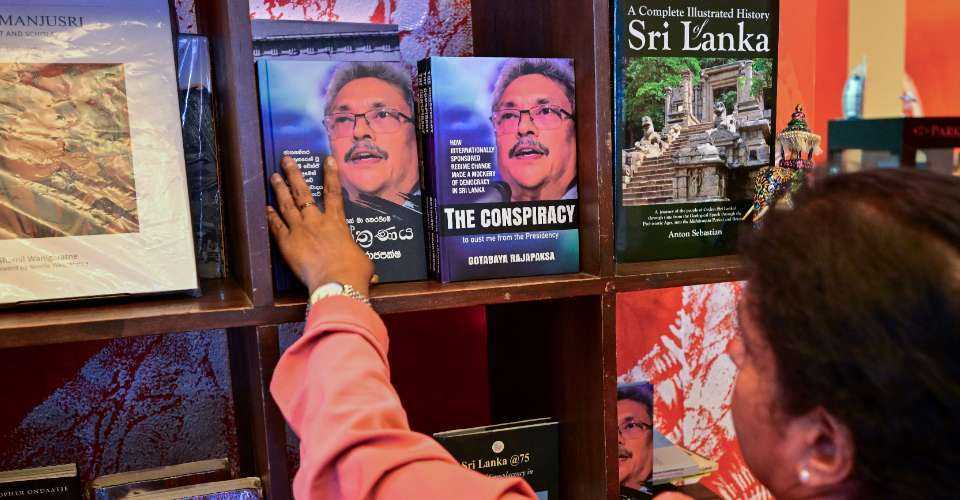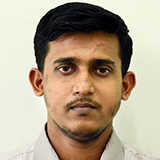
A woman looks at the copies of the ‘The Conspiracy’ book written by toppled Sri Lankan president Gotabaya Rajapaksa displayed at a bookshop in Colombo on March 7. (Photo: AFP)
Sri Lanka’s former President Gotabaya Rajapaksa has alleged in a new book that the Catholic Church played a key role in mass civil protests that blamed him for the nation’s worst economic crisis since independence and unseated him from power in July 2022.
“That the cardinal [Malcolm Ranjith] and sections of the Catholic Church played a major role in my ouster was obvious,” Rajapaksa wrote in his explosive memoir titled “The Conspiracy to Oust Me from the Presidency,” released on March 7.
“The most visible presence at the Galle Face protests was that of the Roman Catholic clergy,” he noted referring to demonstrations at Galle Face Green, a public space near the Presidential Secretariat building.
The sensational claims by the former president and member of the powerful Rajapaksa clan have made the book a bestseller in the Indian Ocean island nation, with the first edition sold out within a few days of its release.
However, the Church has yet to respond to the claims made in the book, although it’s been more than 10 days since its release.
Written in first-person narrative, the memoir claimed that there was an internationally backed conspiracy to oust him from office by various sections of Sri Lankan society, non-governmental organizations (NGOs), and Tamil diaspora outfits in Western countries.
“The Catholic clergy would ‘turn up every morning for the protests'”
The conspiracy was in the making, it claims, “since he assumed duties in November 2019 through a majority of Buddhist votes.”
“Talk of ‘Catholic Action’ and the clandestine political machinations of the Catholic Church was a part of the political discourse in this country some decades ago. But this time, Catholic priests and nuns came out openly onto the streets,” Rajapaksa alleged.
He further details how the Catholic clergy would “turn up every morning for the protests on Galle Face.”
“On 9 July 2022 when mobs took over the President’s House, Catholic priests and nuns were seen among the intruders,” he alleged.
The former president even wonders “given the excellent relationship that existed earlier, why the cardinal and sections of the Catholic Church turned away from me in this manner is a mystery.”
He claims to have maintained close ties with Ranjith before he took office in 2019 while serving as defense secretary under his brother’s government which was unseated in an election in 2015.
“A high point of my relationship with the Catholic Church was the invitation of His Holiness the pope to Sri Lanka towards the end of the Mahinda Rajapaksa government,” he wrote.
Rajapaksa wrote in detail on the lengthy process beginning about two years before the visit when personnel from the Vatican visited the country to conduct security assessments and other preparations.
“The Church was misled to believe in conspiracy theories”
“I became so close to the cardinal during this period that when the visit of the pope took place soon after we had lost power in 2015, he obtained a special audience for former president, Mahinda Rajapaksa, and myself to meet His Holiness at the house of the Papal Nuncio in Colombo,” he claimed in the memoir.
This contact, the former president stressed, remained during the years of “good governance government (2015-2019)” and “I and my wife would occasionally be invited to dinner with the cardinal.”
The close rapport between them underwent a dramatic change when the Catholic Church expressed its disappointment with his government’s probe into the Easter Sunday attack that shook the nation months before Rajapaksa was elected to office.
The deadly terror bombings on April 21, 2019, claimed the lives of 279 people including 37 foreign nationals, and injured over 500 others, most of whom had flocked to churches for Easter Sunday Mass.
The Church said it would be forced to seek “international justice” through other means in the absence of justice and truth over the attacks through local mechanisms.
The former president claimed the Church was misled to believe in conspiracy theories based on selective testimonies of witnesses.
Recalling Ranjith’s allegation, made in mid-January 2022, that certain leaders used the attacks for their political advantage, Rajapaksa claimed he did seek assistance from foreign governments and investigating agencies to ensure legitimacy to the probe assigned to a Presidential Commission of Inquiry.
“What was now being alleged in so many words was that eight Muslim fanatics had launched suicide attacks in order to make me president,” he claimed.
“In early 2022 when the cardinal started making the accusation that I had somehow orchestrated the Easter Sunday bombings in order to create the political conditions for me to get elected to power, I instructed Sri Lankan Ambassador Mahinda Samarasinghe in Washington to explore the possibility of obtaining the US government’s Federal Investigation Bureau/ Central Intelligence Agency assistance in the investigations,” the former president explained.
He further claimed that the US Department of Justice, after a two-year-long investigation by the FBI, filed charge sheets against three Sri Lankan nationals in January 2021 for conspiring to provide materials to ISIS.
“For anyone to suggest that I had the capacity to organize suicide bombings by Muslim terrorists when I was out of power in order to create the political environment needed to bring me to power, is totally absurd,” Rajapaksa said in his defense.
Source: UCA News

